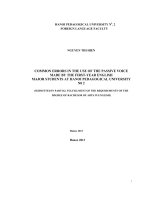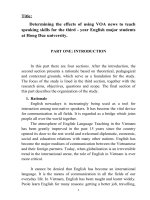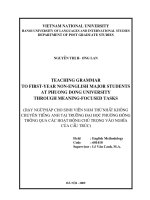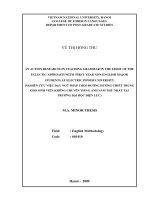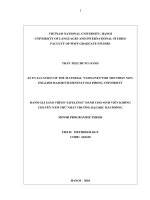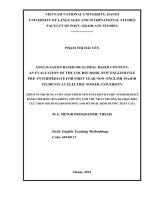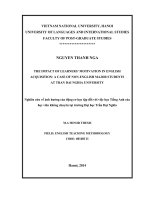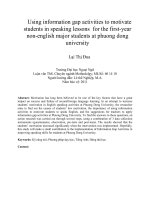Factors leading to pronunciation mistakes when speaking of fourthyear English major students at Thuong Mai University and possible solutions
Bạn đang xem bản rút gọn của tài liệu. Xem và tải ngay bản đầy đủ của tài liệu tại đây (608.77 KB, 60 trang )
ABSTRACT
Pronunciation is an integral part of foreign language learning since it directly
affects learners' communicative competence as well as performance. The limitation in
pronunciation can decrease learners’ self-confidence, restrict social interactions, and
negatively affect estimations of a speaker’s credibility and abilities. The current focus
on communicative approaches to EFL pronunciation learning and the concern for
building communication skills are renewing interest in the role that pronunciation
plays in EFL learners’ overall communicative competence.
This study investigates the factors which affect English pronunciation of fourthyear English major students at Thuongmai University. In other words to find the
obstacles of students and the factors that cause these problems. Then find some
techniques that help fourth-year English major students at Thuongmai University
improve their pronunciation. The method used for researching is quantitative. The
instruments used for collecting the data were interviews, recordings and a structured
questionnaire. The collected data were analyzed both descriptively and artistically.
The purposes of this paper are to identify the features of pronunciation, find out
the common English pronunciation mistakes, explain factors affecting the learning of
pronunciation, discuss the strategies that can help fourth-year English major students
at Thuongmai University improve their pronunciation. The review of literature shows
that with careful preparation and integration, pronunciation can play a significant role
in supporting the learners’ overall communicative skill.
1
1
ACKNOWLEDGEMENT
During the process of conducting my graduation paper, I have received plenty of
enthusiastic help and support from my teachers and friends who have guided and
encouraged me to overcome all difficulties and finish this hard but meaningful time. I
would like to extend my sincere thanks to those lending me a hand in accomplishing
the graduation paper.
First of all, I would like to express my gratitude and appreciation to the teachers
of The English Faculty at Thuongmai University, who have imparted golden
knowledge to me. From these supports, I can improve me English skills and have a
good background to achieve my dream.
Secondly, I sincerely thank Master Do Thi Bich Dao, my supervisor who has
given me useful guidance and advice for finishing my graduation paper successfully.
Last but not least, I am grateful to all of the lovely English major students of
Thuongmai University who contributed and had warm cooperation to help me during
the process I carried out my survey.
In short. I am really thankful to all people helping me to finish my graduation
paper.
Thank you sincerely!
Ha Noi, November, 2020
Nguyen Huu Ngoc Anh
2
2
TABLE OF CONTENTS
3
3
LIST OF TABLES AND FIGURES
4
4
LIST OF ABBREVIATIONS
L1
L2
EFL
ESL
5
First language
Second language
English as a foreign language
English as a second language
5
CHAPTER 1: OVERVIEW OF THE STUDY
1.1. Rationale
In recent years, English has been one of the most commonly used languages in
the world. English is not only used for communication purposes but also used in many
other fields such as tourism, foreign trade, culture exchanges etc. among a lot of
countries around the world. In the context of globalization in Vietnam, English is also
used as the second language and plays an important role for students when
communicating. Nonetheless, most of the students focus on reading and writing skills
rather than speaking. They spend a lot of time learning grammar to deal with tests and
exams rather than practicing pronunciation and speaking skills in class and at home to
improve their communication skills. Therefore, it is quite obvious that students are
afraid of speaking English. Moreover, like students elsewhere in the non-English
speaking countries, Vietnamese students encounter great difficulties in learning
English pronunciation because they have little opportunity to contact with native
speakers in the target language while teachers are the main source of modelling
pronunciation in the classroom. During my English learning at Thuongmai especially
my own experience in learning Phonetics and Phonology subject in the third year.
However, I find out that if I spend more time on practicing, the English pronunciation
problems will be overcome and I really want to enhance my English pronunciation.
For these reasons I mentioned above, I have decided to carry out a study on: “Factors
leading to pronunciation mistakes when speaking of fourth-year English major
students at Thuong Mai University and possible solutions” to research.
1.2. Previous studies
There have been a lot of outstanding studies which research the factors affecting
the English pronunciation. These studies not only gave the author valuable reference
material but also inspired the author to conduct this study to fulfill the gap left by
them.
6
1.2.1. Foreign studies
Firstly, the study “Non-Native Pronunciation of English: Problems and
Solutions” was written by Norma. It was issued in September 2017 (Vol.7, No.3) in the
American International Journal of Contemporary Research. The aims of the study
include: Finding the obstacles that Jordanian students face in pronunciation, as a result
of linguistics interference, investigating the factors that cause the phonological
interference between Arabic and English, and trying to find fundamental solutions for
this problem and trying to find fundamental solutions for these obstacles. The study is
also conducted with the research questions: What are the obstacles that Jordanian
students encounter in English pronunciation? What factors cause these obstacles? And
what solutions can be suggested to ease these obstacles? The author uses some
methods to do the research with Jordanian students such as: oral interview and
pronunciation test. The research subjects are the obstacles that Jordanian students
encounter in English pronunciation, causes and solutions for the obstacles. Finally, the
author obtained the following research results: the English Jordanian students in both
universities committed different kinds of errors in: vowels, diphthongs, consonants,
stress, and consonant clusters, an important challenge the Jordanian students
encountered in the pronunciation test is “the consonant cluster”, the differences
between Arabic and English in: Vowels, diphthongs, consonants, consonant cluster,
and stress create errors in pronunciation for the Jordanian students and there was an
urgent need to find some solutions that could help the English Jordanian students to
encounter such a problem.
Secondly, “Discovering factors that influence English pronunciation of native
Vietnamese speakers” was conducted by Leah Tweedy in August 2012. The purpose of
this study is to uncover the factors that lead to intelligibility issues for a native
Vietnamese woman tested as proficient in English. The study was carried out with
three research questions: What are native Vietnamese women's attitude toward
learning North American? What is the specific pronunciation background? And what
are the different factors influencing the native Vietnamese women’s English
pronunciation? The research subjects are native Vietnamese women's attitude toward
learning North American, the specific pronunciation background and the different
7
factors influencing the native Vietnamese women’s English pronunciation. Research
methodology includes a survey questionnaire and interview. At the end of the research,
the author concludes that the participant’s age at arrival, first language influence, and
lack of directed pronunciation instruction appear to have all contributed to
intelligibility issues, the participant’s positive attitude and motivation toward acquiring
clear pronunciation and language exposure have likely been positive influences and
the participants do exhibit pronunciation errors that interfere with intelligibility, but
intelligibility improves when the participant is allowed to speak freely about familiar
topics and select her own words.
Thirdly, “The Pronunciation Errors of L1 Arabic Learners of L2 English: The
Role of Modern Standard Arabic and Vernacular Dialects Transfer” was carried out by
El Zarka, Amro Mohamed El Said in October 2013. It was published by The British
University in Dubai. The purpose of this study is to concentrate on English
pronunciation errors made by native Arab speakers, while they make conversation,
deliver speeches or give presentations. The research questions are divided into two
parts: In what way do vernacular dialects of Arabic affect the pronunciation of English
as a second language? And what are the common errors and repair strategies the
participants employ? The two questions also are the research subjects of the author.
The quantitative and the qualitative methods are used to do the research. At last, the
given research results are: intelligibility is the core of any communication process and
pronunciation is its tool, in one’s native language the other party might tolerate an
accent, fast speech, falling tones etc., as they can still get the message and when
learning a second language the significance of proper pronunciation doubles.
1.2.2. Domestic Studies
In Tam’s graduation paper written 2005, the researcher conducted a study named
“Common pronunciation problems of Vietnamese learners of English”. The aim of the
study is to find out English department students’ common pronunciation problems.
With research subjects are the common pronunciation problems of Vietnamese learners
of English, the given research question was “what are the most common pronunciation
problems of the students in the English department?”. The research methodology is
8
oral examinations. Lastly, the author concludes that the sounds most frequently
mispronounced by the informants include: /z/, /tʃ/, /f/, /z/, /ch/, /s/, since language
learning, like music, painting or architecture, requires some gift from learners, aptitude
test would be necessary in order to get rid of students who have language deficiency,
for instance people with confusion of /1/ and /n/, as language aptitude exam is still not
possible, it would be desirable to use “task force” periods for pronunciation practice to
help improve then- pronunciation.
Secondly, “A study on common pronunciation mistakes and recommended
solutions to improve receptionists’ English speaking skills at Sea View Hotel” was
carried out by Nguyen Thi Tam and issued in April 2019 at Hai Phong private
university. The aim of the study is to help receptionists realize their ending sounds
errors and find out some solutions for receptionists’ pronunciation problems. The
research questions include: What is the most common pronunciation mistake that
receptionists at Sea View Hotel tend to make when speaking English? What are the
ending sound errors that receptionists’ are likely to face? And what are solutions to
help receptionists’ avoid pronunciation mistakes and solve their problems? The three
given questions are also the research subjects. The research methodology was a survey
questionnaire and the research subjects were receptionists at Sea View Hotel. In the
end, the author concluded that there are 5 common ending sounds that receptionists
tend to make when speaking English in work: /dʒ/, /θ/, /ʃ/, /ð/ and /ʒ/.
Thirdly, the study “A Case Study of Solutions to Some Intonation Mistakes” was
conducted by Dieu (2015). The final target of the study is to improve Vietnamese
students’ pronunciation skill as well as catching the main idea in the conversation in
order to have successful communication in English. The research includes two
questions: What is the effect of combining Phonological Knowledge, Rhythm and
Melody in Teaching English Intonation Strategy? And what are the students' thinking
of the treatment and students' attitude towards English intonation? The research
subjects are the effect of combining Phonological Knowledge, Rhythm and Melody in
Teaching English Intonation Strategy and the students' thinking of the treatment and
students' attitude towards English intonation. The research is the combination of
quantitative and qualitative methods. The given results of the research are that without
9
a sufficient, threshold-level mastery of the English prosodic system, learners’
intelligibility and listening comprehension will not advance, no matter how much
effort is made drilling individual sounds, and teachers should spend more time training
students how to count the number of syllable in a word, identify the syllable weight
and should be given to the training process of this new strategy and more research is
needed into how to use this strategy effectively to make students accustomed to
applying this method, especially on their own independently for their extra
communicative.
1.3. Aims of the study
With the hope of getting a more comprehensive and specific understanding of
English pronunciation, this study will help fourth-year English major students at
Thuongmai University realize their pronunciation mistakes in consonants, ending
sounds, word stress and intonation. Besides, the study also gives some suggestions to
deal with common pronunciation problems of fourth-year English major students at
Thuongmai University.
In order to achieve these mentioned aims, the study is my effort to find the
answers to the following research questions:
1. What are the situations of fourth-year English major students at Thuong Mai
University toward English pronunciation?
2. What are the common mistakes in English pronunciation of fourth-year
English major students at Thuongmai University?
3. What factors affect English pronunciation of fourth-year English major
students at Thuongmai University?
4. What are the suggestions to deal with pronunciation problems of fourth-year
English major students at Thuongmai University?
1.4. Research Subjects.
The subjects of the study are the situations of fourth-year English major students
at Thuong Mai University toward English pronunciation, the common mistakes in
10
English pronunciation of fourth-year English major students at Thuongmai University
(mistakes in consonants, word stress, ending sounds and intonation), the factors affect
English pronunciation of fourth-year English major students and some suggestions to
deal with the pronunciation problems.
1.5. Scope of the study.
Firstly, the researcher would like to find out the factors which affect English
pronunciation, thus the study focuses on the situations of students, the common
mistakes and the factors causing English pronunciation obstacles and suitable solutions
for them.
Secondly, the author will pay much attention to four issues including consonants,
ending sounds, word stress and intonation mistakes. The results of this study will be
based on the survey questionnaire that is given to 90 fourth-year English students
whose English are supposed to be at the intermediate level upward. Studying at
university for more than three years, this group of students would be quite accustomed
to the academic environment at university and would have a solid foundation in
English pronunciation
Thirdly, the researcher only shows concern about the student’s attitudes toward
English pronunciation and factors which affect the English pronunciation of them.
Thus, the collected data were derived from their own experience in practice and were
not influenced by other factors such as friends or family. The author hopes that this
study will be useful material for every student who concerns this problem and wants to
improve pronunciation mistakes when speaking.
1.6. Research methodology
All related data for this study were collected from 90 fourth-year English major
students at Thuongmai University by survey questionnaire. The participants were
fourth-year English major students at Thuong Mai University who were taken
randomly from all 6 classes: N1, N2, N3, N4, N5 and N6.
11
The study was conducted with a survey research design. Questionnaire and
interview were two methods which were chosen to conduct this survey. The first
instrument was a questionnaire consisting of several parts. The first part referred to the
situations of fourth-year English major students towards English pronunciation, “How
long have you been learning English?”, “Which level is the result of your English
Phonetics and Phonology subject?”, “How often do you make pronunciation mistakes
when you speak?”, “Do you like subjects relating to pronunciation such as Speaking
and Phonetics and Phonology?”, and “Do you often practice pronunciation at home?”.
The author used a 4-point Likert scale, from A to D to discover the respondents’
attitudes toward learning and practicing English pronunciation. Research subjects
showed their interest and frequency in descending order from A to D. Part two
included a question which aimed at answering the question: “What are the common
English pronunciation errors when you speak?”. The author listed several errors such
as: consonants, ending sounds, word stress and intonation. The researchers used 4point Likert scale to discover the degree to which participants thought the variables
had affected their pronunciation. In third part, the researcher would like to find out the
answer the question: “What factors affect your English pronunciation?”. Many factors
were listed by the author such as: the native language, exposure to English and native
speakers, phonetic ability, background knowledge of learners, attitude and motivation.
The researcher used 4-point Likert scale to discover the degree to which participants
thought the variables had affected their pronunciation. The participants were to mark
how these factors affect their English pronunciation by circle the number from 1 – Not
at all to 4 - Significantly.
The respondents were requested to provide the data and most of them spent
approximately 15 minutes to complete the questionnaire. The questionnaire was
piloted with three voluntary respondents and then gave out to all 90 participants. The
quantitative data gained from three parts: II, III, IV of the questionnaire were
calculated and transferred into numerical form with regard to the items’ percentage of
participants who share similar answers.
The second instrument was interviews which were conducted with a view to
investigate further attitudes of fourth-year English major students at Thuongmai
12
University toward English pronunciation and then find out the factors that affect their
English pronunciation the most. The researcher selected twenty volunteers out of 90
participants. In these interviews, the researcher would like to research thoroughly four
main questions in the questionnaire by asking twenty participants some more
questions. Then the researcher asked for some suggested solutions from these subjects.
1.7. Organization of the study.
This study consists of four chapters:
Chapter 1, Overview of the study, provides an overview of the study in which the
reasons for choosing the study were presented. It also includes the aims of the study
rationale, previous studies, aims of the studies, research subjects, scope of the study,
research methodology and organization of the study.
Chapter 2: Literature review provides the definition of English pronunciation, its
importance in speaking English and factors affecting on pronunciation learning. The
common mistakes in consonants, word stress, ending sounds and intonation are also
presented in this chapter.
Chapter 3: Research findings: Based on the data collection from a survey
questionnaire, the issues will be analyzed in depth in order to provide realistic
information about consonants, word stress, ending sounds, and intonation mistakes of
fourth-year English major students at Thuongmai University.
Chapter 4: Recommendations to deal with pronunciation problems of fourth-year
English major students at Thuongmai University: This chapter also is about some
recommendations to avoid students’ pronunciation problems which are mentioned
above and solutions in order to help English major students at Thuongmai University
have good pronunciation.
13
CHAPTER 2: LITERATURE REVIEW
The current chapter presents a review of literature which is related to the
definition of English pronunciation, the standard English pronunciation and the
importance of correct English pronunciation. More importantly, factors affecting
English pronunciation would also be highlighted.
2.1. English pronunciation
2.1.1. Definition of pronunciation
Tesi di Laurea (2004) defined in “A Study on Teaching English Pronunciation in
Primary Schools in Italy” that “Pronunciation refers to the production of sounds that
we use to make meaning”. “It includes attention to the particular sounds of a language
(segments), aspects of speech beyond the level of the individual sound, such as
intonation, phrasing, stress, timing, rhythm (suprasegmental aspects), how the voice is
projected (voice quality) and, in its broadest definition, attention to gestures and
expressions that are closely related to the way we speak a language”.
Besides, Cook (1996) defined pronunciation as “the production of English
sounds”. English pronunciation is learnt by repeating sounds and then correcting them
when produced wrongly. When learners start learning pronunciation, they make new
habits and overcome the obstacles resulting from the L1.
According to Pourhosein Gilakjani (2012), pronunciation is defined as “the
method of producing the sounds for constructing meaning”. It includes consonants and
vowels of a language (segments), features of speech such as stress, intonation, timing,
rhythm, phrasing (suprasegmental features), and voice quality. All of the mentioned
elements can work together when speakers speak so that difficulties in one element
may affect another and this may make an individual’s pronunciation easy or difficult to
understand.
Other reliable pronunciation definitions include Richard and Schmidt (2002)
stating, “pronunciation as the way certain sounds are produced. Pronunciation
emphasizes the way sounds are understood by the listeners. They continued that
pronunciation is a significant part of English because mispronunciations make it
difficult for listeners to understand the meaning of sentences correctly”.
14
There are so many different definitions of pronunciation, the researcher considers
pronunciation is the way in which a word is pronounced.
2.1.2. The importance of pronunciation.
As mentioned above, pronunciation is a very important element for every student
learning English. And the most important purpose of each learner is to be able to
pronounce being the same or similar to native speakers. Even if students have a good
grammar foundation, a rich vocabulary source, but they cannot pronounce accurately,
they are not highly appreciated or even difficult for foreigners to understand them.
According to Fangzhi (1998:39), that it is important to pay attention to
pronunciation since it results in whether or not someone's message can be passed or
not by other people. In addition, Gilbert (cited in Otlowsky (2004:3) stated that if
someone cannot hear English well, she or he is cut off from the language. And if
someone cannot be understood easily, she or he is cut off from conversation with
native speakers. Pronunciation is an essential thing in good communication because
the wrong pronunciation will lead to misunderstanding and negative impressions with
the other person.
Researching about pronunciation goals, Joanne Kenworthy (1987) wrote in
Teaching English Pronunciation that "We come to the question of what goals should be
set for individual learners or groups of learners. How "good" should the learner's
pronunciation aim to be? Whereas some time ago it might have been said that the goal
should always he native - like pronunciation, even though it was realized that this
would be achieved by relatively few, most people now think that this is an
inappropriate goal for most learners. The great majority of learners will have a very
practical purpose for learning English and will derive no particular benefit from
acquiring a native - like pronunciation
According to AMP Fact sheets of AMP Research Centre, “learners with good
pronunciation in English are more likely to be understood even if they make errors in
other areas, whereas learners whose pronunciation is difficult to understand will not be
understood, even if their grammar is perfect” and “Yet many adult learners find
pronunciation one of the most difficult aspects of English to acquire, and need explicit
help from the teacher (Morley 1994; Fraser 2000). Surveys of student needs
15
consistently show that our learners feel the need for pronunciation work in class (egg
willing 1989). Thus some sort of pronunciation work in class is essential”.
From Higgs Graph of Learner Needs, pronunciation is something that is very
important to beginners. It allows them to feel more comfortable when speaking.
Obliviously, no one can deny the importance of pronunciation. It is considered as one
of the most significant factors in English speaking. Therefore, students should take
more notice of pronunciation in order to have good speaking.
Therefore, “pronunciation instruction is of great importance for successful oral
communication to take place since it is an important ingredient of the communicative
competence” (Hismanoglu, 2006).
2.2. Factors affecting pronunciation learning.
Although some researchers believe that all learners have the same capacity to
learn a second or foreign language because they have learned their first language, a
number of EFL teachers have difficulties in improving the students’ pronunciation
problems. As a result, in the past, several researchers have put great efforts, asserted
and suggested many factors affecting students’ pronunciation (e.g. Brown, 1994;
Celce-Murcia et al., 2000; Gillette, 1994; Kenworthy, 1987). In this regard, these
previous studies have been repeatedly substantiated that factors such as the native
language, exposure, phonetic ability, background knowledge, attitude, and motivation
and concern for good pronunciation ability, appeared to have an influence on teaching
and learning pronunciation.
2.2.1. The native language.
According to Avery and Ehrlich (1987), learners of a language have different
ways to speak the target language. The way they speak the target language is
sometimes slightly different and sometimes highly different than the native speakers’
do. Kenworthy (1987) also stated that the native language is the most influential factor
in accounting for students’ pronunciation, especially foreign accents. That is, if the
students are familiar with the sound system of their native language, they will be able
to effectively diagnose their own difficulties. Kenworthy suggested that many first and
second language carryovers can be overcome through a focused awareness and effort
on the learners’ part. In this sense, as asserted by Senel (2006), it should be noteworthy
that interference or negative transfer from the first language is likely to cause errors in
16
aspiration, intonation, rhythm, and melody in the target language. To illustrate, this
problem can occur when the rules for combining the sounds in forms of syllables are
different in two languages.
2.2.2. Exposure to English and native speakers
“Exposure, it is difficult to define” (Brown, 2007). Generally, it is relevant to the
length of time that the learners live in a target language environment. No matter where
the learners live, the matter should be considered is how much the learners use English
in the daily conversation. The more learners spend time on speaking and listening
English, the better English pronunciation will be.
Regarding the factor to learners’ exposure, it seems that people who are exposed
to the L2 before the age of puberty seem to acquire all languages equally. However, it
does not simply mean that learners who live in the target language country will have
good native-like pronunciation. The crucial point is whether the learners grasp all
opportunities to use the target language and to take full advantage of the environment.
If the learners have been living in an English-speaking country, then the learners will
have many opportunities to listen to and to use English since they will be surrounded
by the English- speaking environment. In addition, it is very important that they have
the desire to associate with native speakers and get to know the new culture and
customs.
However, it should bear in mind that there are many learners who live in Englishspeaking countries, but spend much time within a non-English speaking environment
or communicate with the native-speaking group even though these learners are in
English- speaking countries. This is the reason why it is not merely exposure that
matters, but how the learners respond to the opportunities. Senel (2006) stated that,
“Exposure can be a contributory factor, but it cannot be a whole and necessary factor
for the development of pronunciation”. If a learner is aware of the necessity of being
exposed to the target language, learners should make use of its opportunities. If the
learner does that, these learners will be more successful in case of improving
pronunciation.
2.2.3. Phonetic ability
According to Brown (1992), phonetic ability is sometimes called phonetic coding
ability. It is a common view that some people have a better listening skill for a foreign
17
language than others. Therefore, they are able to discriminate between the two sounds
more accurately than the others and are able to imitate sounds better. Although
students may have had exposure to a foreign language as children and attuned to
phonetic discrimination, some studies (e.g. Kanoksilapatham, 1992) have suggested
that some elements of learning are a matter of awareness of the different sounds. Also,
learners’ pronunciation ability can be improved by putting effort and concentration on
those sounds.
2.2.4. Background knowledge of learners
Lacking of English pronunciation knowledge is another prominent problem to
advancing in English pronunciation. Several studies compared the pronunciation
accuracy of people having good English pronunciation knowledge and those who did
not, revealing the difficulty with pronunciation of learners who did not have English
pronunciation knowledge in mastering English pronunciation. For instance, Siriwisut
(1994) and Serttikul (2005) indicated that language knowledge had an effect on
pronunciation ability. In their studies, language knowledge meant the awareness to use
English language correctly. The studies suggested that students with poor
pronunciation, who were regarded as less knowledgeable, had more language transfer
problems than the students with good pronunciation. For this reason, the students with
good pronunciation would improve better than the poor ones.
2.2.5. Attitude
Many research studies conducted over the years have shown that attitude is an
important factor for foreign language acquisition, especially in the pronunciation of
English. As early as 1975, Gardner and Smythe indicated that attitude promotes
motivation and motivation promotes second language achievement. Similarly, Clément
(1980) showed that EFL learners who have a positive attitude towards learning a
foreign language use the language more frequently and are more motivated to go on
learning the language. Sparks and Glachow’s work (1991) on personality found similar
results. In other words, if students with encouragement to learn positive attitudes
towards the target language and their speakers have been more successful than
students with less positive attitudes..
2.2.6. Motivation
If the learners are highly motivated to have a better pronunciation, they can
develop a concern for pronunciation, and become more eager to take part in the
18
activities and pay more attention to discriminate the sounds of the target language, and
they try to produce better utterances. Motivation can be the key to learn the target
language, and they try to produce better sounds. Here it must be pointed out what the
motivation is and how the learners will be motivated. According to Brown (1997:114115) the motivation is thought of as an inner drive, impulse, emotion, or desire that
moves one to a particular action. He also stated that learning a foreign language
requires some of all three levels of motivation which can be global, situational, or taskoriented. For example, a learner may possess high global motivation but low task
motivation on the written mode of the language.
Motivation for learning also can support or impede pronunciation (Florez, 1998).
Elliott (1995) showed that a student’s motivation toward achieving the target
language’s pronunciation was the principal variable in their accuracy of actual
pronunciation output.
We still found that the students’ motivation is of importance in his or her
pronunciation learning. And sometimes, some students speak English when they
receive others’ praise for their beautiful English, which might give them a strong sense
of achievement.
2.3. The common mistakes in English pronunciation
When learning English pronunciation, it is so difficult for English learners to
make the sounds being the same and close to these sounds of native speakers. Making
mistakes in pronunciation is unavoidable, especially for new English learners when
they study English as a second language. According to Dulay, Burt and Krashen
(1982), “mistake can be defined as the flawed side of learner speech or writing”, which
“deviates from some selected norm of mature language performance”.
Besides, Richards (1971) acknowledges two different kinds of errors:
performance errors, caused by, such as, fatigue and inattention, and competence errors
resulting from lack of knowledge of the rules of the language.
In another research, Ellis (1997) states that errors reflect gaps in a learner’s
knowledge; they occur because the learner does not know what the correct one is.
However, mistakes reflect occasional lapses in performance because in particular
instances, the learner is unable to perform what she or he knows Ellis (1997).
19
In short, every English learner would make pronunciation mistakes at least
several times while they learn English pronunciation and each one has their own
problem.
2.3.1. Consonants
There are many mistakes of pronunciation that English learners often make when
speaking English such as ending sounds, word and sentence stress or intonation etc.
But this part will pay attention to some consonants that English major’s students at
Thuongmai university make mistakes.
Figure 2.1. Consonants and vowels in English by Pedro Gumie
2.3.1.1.
Definition
In the Oxford Advanced Learner’s Encyclopedic (1992), consonant is clearly
defined: “speech sounds made by completely or partly stopping the flow of air
breathed out through the mouth”. Consonants is also defined “A speech sound that's
not a vowel; a letter of the alphabet that represents a speech sound produced by a
partial or complete obstruction of the air stream by a constriction of the speech
organs”.
2.3.1.2.
The common consonant mistakes
To examine the problems that Vietnamese speakers meet when they learn to
speak English, the author will explain general problems based on the work of several
linguists. The author shall also point out specific problems based on her own learning
and teaching experiences.
According to Honey, "the Vietnamese consonant system is very different from
that of the English, and there is considerable variation between dialects. Vietnamese
20
learners of English can be expected to come across particular difficulty with some or
all of the following sounds: /f/, /θ/, /ð/, /z/
Vietnamese speakers can pronounce words with final voiceless stop
consonants /p/, /t/ and /k/, as these voiceless stop consonants occur at the final position
of a word in Vietnamese. However, Vietnamese speakers pronounce these consonants
with extremely short duration, and therefore, the sounds are never released at the end
position of a word. It can be very difficult for English native speakers to hear these
sounds from Vietnamese speakers. For example, a Vietnamese learner of English
producing the word seat may sound like see (Avery and Ehrlich, 1992, p. 153).
2.3.2.
2.3.1.1.
Ending sound
Definition
In English, attention to ending sounds is a very important factor in pronunciation.
To understand easily, “ending sounds” are sounds that occur at the end of the word. It
refers to the consonant sounds as the word can end with one or more consonant sounds
(consonant clusters). According to Davis, “the coda is the final consonant or
consonant cluster.” Rachael-Anne Knight (2003) states that there are 4 consonants in a
coda. If there are no consonants at the end of the word, it has a zero coda.
2.3.1.2.
The common ending sound mistakes
According to Mark (2008), ending sound errors can be defined as “the inaccurate
pronunciation of the final consonant in a word”. The classifications of ending sounds
errors were given out according to Treiman (1989). They are: Cluster reduction,
Cluster Simplification, Epenthesis, Coalescence, Omitting nasal and liquid sounds and
phonetically possible spelling.
Hereunder is introduction about 6 types of ending sounds errors according to
Treiman (1989):
Cluster reduction: This is the “deletion of one or more consonants from a target
cluster so that only a single consonant occurs at syllable margins” (Grunwell, 1987:
217, as cited in Treiman (1989)).
Cluster Simplification: The error occurs when one/some elements of a cluster
being is/are produced in a different manner from the target phoneme (Grunwell (1987),
as cited in Treiman(1989))
21
Epenthesis: This is the insertion of some vowel (normally a schwa) between
cluster elements (Dyson & Paden (1983), as cited in Treiman(1989))
Coalescence: It occurs when the yielded pronunciation contains a new consonant
composed of features from the original consonants. (Dyson & Paden (1983), as cited
in Treiman(1989)).
Omitting nasal and liquid sounds: In consonants cluster consisting of prefinal+
final consonants with nasals (/n/,/m/) or liquids (/r/,/l/) as the first element, (/m, n, l, r/
+ final consonant), nasals and liquid sounds are often omitted (Treiman, Zukowski &
Richmond, Wetly, (1995)).
Phonetically possible spelling: In representing the first consonant of a cluster,
spellers tend to spell words in an inaccurate but phonetically plausible ways (Treiman
&Bourassa. (2000)).
In her research, ending sound errors were divided into 3 groups: Reduction is
omitting the final consonant or one element of a cluster, insertion is inserting a
consonant to the ending of word and substitution is replacing an English consonant by
a phonetically similar of Vietnamese sound. In current study, the findings of students’
tapes recorded and observation will be analyzed according to the three types of errors
mentioned above.
2.3.3.
Word stress.
2.3.3.1. Definition
When studying English, word stress is one of the most important factors that
students have to attend and spend a lot of time studying and practicing. What is the
definition of word stress? Students can understand easily that stress is often called to
indicate how strong or weak the sound is.
According to Macmillan English Dictionary (2002): “The stress accent on
syllables of individual words either in a sentence or in isolation”.
Besides, the definition of word stress is shown in Put English Phonetics into
Practice compiled by Szilagyi Laszlo (2014) that “in English, we do not say each
syllable with the same force or strength. In one word, we accentuate ONE syllable. We
say one syllable is very strong, and all the other syllables are very quiet”.
2.3.3.2. The common word stress mistakes
Vietnamese and English differ a great deal, with Vietnamese being syllable-timed
and tonal, and English being stress-timed and non-tonal. For example, when English
speakers change intonation to signal a question, Vietnamese speakers change tone to
22
distinguish between two completely different words. Also, Vietnamese speakers tend
to give each syllable the same amount of time, while English speakers follow a rhythm
where stressed syllables happen at regular intervals. This disparity indicates that native
Vietnamese speakers can be expected to have difficulty acquiring appropriate English
stress and rhythm patterns (Byrne, Butcher, & McCormack, 1996)
Moreover, Vietnamese people often have the wrong way of pronouncing word
stress in English. They tend to pronounce the stress in a too loud voice or too long
sound. It is pointed out by Nguyen (2000a: 79) that in case of bi-syllabic words, the
stressed syllable (if known to the speakers) is produced with a greater loudness. It is
natural that the vowel is over-lengthened as in: (e.g. IM.por.tant vs. im.POR.tant)
It is proved by Nguyen (2000a) that stress production by Vietnamese learners is a
combination of duration and loudness of utterances. From that definition, we can see
that the production of English word stress by Vietnamese speakers also lacks pitch
height and vowel quality. This point of view is partly shared by Nguyen (2005), who,
through her research, finds out that Vietnamese beginners of English fail to produce
stressed syllables long enough. The case does not really apply to Vietnamese advanced
learners, which may be an indication that Vietnamese students can be trained to
produce correct stress in English words. This coincides with the researcher’s
experience in teaching English pronunciation: when asked to produce word stress, her
students (at elementary level) tend to exaggerate it by making it longer and louder (and
certainly lacking pitch height and vowel quality), whereas students of upperintermediate or advanced levels usually get it correct right from the first time practice.
2.3.4.
2.3.4.1.
Intonation.
Definition
According to R. Kingdon (2003): “when we talk about English intonation we
mean the pitch patterns of spoken English, the pitch tunes or melodies, the musical
features of English”.
Moreover, in “Phonetics and Phonology Book” of Thuongmai University (by
Peter Roach – 1998), intonation defined “is the melody of the sentence. Intonation is
created by changes in the pitch of the voice (the voice goes higher and lower, remains
on the same level, rises or falls), by sentence stress (strong stress on important words,
23
weak stress or no stress on less important words), and by rhythm (stressed syllables
occur at more or less equal intervals)”.
2.3.4.2.
The common intonation mistakes
According to Dieu (2015), there are seven types of English intonation mistakes
when Vietnamese students pronounce a fragment/ tone unit.
Type 1: Mistake of rhythmic pattern (A). Even though students identify stress on
the right syllable, pronounce each syllable with equal force to make the intensity
difference between the peak of 2 or 3, 4 the syllables zero, or just a minor difference.
Type 2: Mistake of tonic syllable identification (B) = not stress on the tonic
syllable. Students place stress on the wrong syllable.
Type 3: Mistake of rhythm and tonic syllable identification (A + B)/ Students
neither place stress on right syllable nor adapt the rhythmical pattern S_W (S: Strong,
W: weak).
Type 4: Mistake of intonation pattern (C). Students make wrong pitch contours
due to being unable to identify the intonation pattern in which this kind of sentence
should be pronounced with raising or lowering voice.
Type 5: Mistake of rhythmic and intonation pattern (A +C). Students neither
adapt the rhythmic patterns nor intonation patterns.
Type 6: Mistake of tonic syllable identification and intonation pattern (B +C).
Students neither stress on the tonic syllable of a tone unit nor adapt the intonation
patterns
Type 7: Mistake of rhythm, tonic syllable identification and intonation pattern (A
+ B+C). The combination of the three types of mistake: rhythmical pattern (A), tonic
syllable identification (B) and intonation pattern (C): students place stress on the
wrong syllable, cannot pronounce with rhythm (the intensity difference between the
peaks of 2 or 3, 4 the syllables are zero, or just a minor difference) and make the
wrong pitch contour.
24
CHAPTER 3: RESEARCH FINDINGS
In this chapter, all data collected from the questionnaire and the interview were
analyzed and discussed to provide answers for the four research questions.
3.1. Data analysis
3.1.1. Research question 1: What are the situations of fourth-year English
major students at Thuong Mai University toward English pronunciation?
3.1.1.1. Number of years student have been learning English
In order to find out the attitudes of fourth-year English major students at Thuong
Mai University toward English pronunciation, it is important to collect information
relating to the number of years students have been learning English.
Figure 3.1 Number of years students have been learning English
As can be seen, it is clear that the period of over 3 years accounts for the largest
section with 42.2% and the second large section is 2-3 years with 26.7%. 1-2 years and
less than 1 years make up 24.4% and 6.7% respectively. This proves that most fourthyear English faculty students at Thuongmai University have been learning English
pronunciation more than 3 years and a few students are exposed to English
pronunciation learning.
3.1.1.2. The distribution of participants by level of Phonetics and Phonology
subject’s score
Figure 3.2. The distribution of participants by level of Phonetics and Phonology
subject’s score
The next question revealed that the number of students who reach level A (8.510) are 34 students, accounting for 48.9%, while only 1 student gets level D (4.9-5.4),
making for 1.2. The percentage of students who get level B (7-8.5) make up 37.8%
and 12.2% of English faculty students at Thuongmai University achieve level C.
Collected data show that there is no student out of 90 participants got level F (0-3.9)
25
